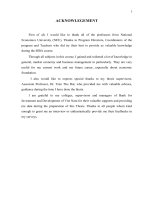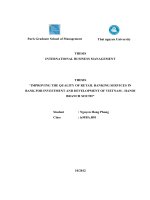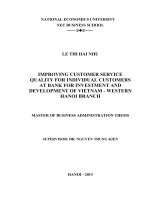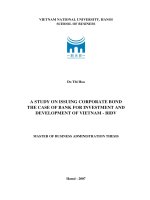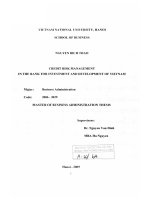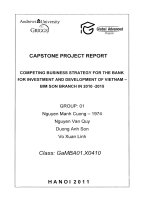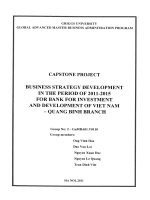develop marketing skills of customer relationship experts in bank for investment and development of vietnam, ha tinh provincial branch
Bạn đang xem bản rút gọn của tài liệu. Xem và tải ngay bản đầy đủ của tài liệu tại đây (1.64 MB, 58 trang )
MINISTRY OF FINANCE
ACADEMY OF FINANCE
FACULTY OF FOREIGN LANGUAGE
====== ======
GRADUATION PAPER
DEVELOP MARKETING SKILLS OF CUSTOMER
RELATIONSHIP EXPERTS IN BANK FOR INVESTMENT AND
DEVELOPMENT OF VIETNAM, HA TINH PROVINCIAL
BRANCH
TRẦN THỊ THU HÀ
CQ47/51.02
Hanoi – 2013
MINISTRY OF FINANCE
ACADEMY OF FINANCE
FACULTY OF FOREIGN LANGUAGE
====== ======
DEVELOP MARKETING SKILLS OF CUSTOMER
RELATIONSHIP EXPERTS IN BANK FOR INVESTMENT AND
DEVELOPMENT OF VIETNAM, HA TINH PROVINCIAL
BRANCH
SUMMITED IN PARTIAL FULFILMENT OF THE REQUIREMENTS
FOR THE DEGREE OF BACHELOR OF ART IN ENGLISH FOR
FINANCE AND ACCOUNTING
STUDENT
: TRẦN THỊ THU HÀ
CLASS
: CQ47/51.02
SUPERVISOR
: MA. TRẦN THU HOÀI
Hanoi - 2013
ACKNOWLEDGEMENT
To begin with, I would like to give my sharp thank to my supervisor
MA. Tran Thu Hoai for helping, suggesting and encouraging me during the
time I research for and write this paper.
I am also indebted to Bank for Investment and Development of Viet
Nam, Ha Tinh provincial branch for giving me permission to take part in the
internship program, to do necessary researches, collect data and complete my
own paper.
I have furthermore to thank the director of the BIDV Ha Tinh branch
who confirmed my study and facilitated me to go ahead with the research.
Especially, I am really happy when I always have my family by my side
and I want to thank them all for their love and encouragement to me.
Finally, because of the limitation of time and knowledge, mistakes are
unavoidable. So, I hope to receive more comments and contributions to make
my paper better.
Page i
ABSTRACT
In the current economic recession, especially when the number of
bankrupt enterprises is rising, the term of marketing sale has become more
and more important, for commercial banks in general, and Bank for
Investment and Development of Viet Nam, Ha Tinh provincial branch in
particular. Therefore, my paper with the topic “Develop marketing skills of
customer relationship experts in Bank for Investment and Development of Viet
Nam, Ha Tinh provincial branch.” will point out the importance of practicing
marketing skills in customer relationship experts’ work.
The main content is reflected in three chapters. The first chapter is about
the literature review for every commercial bank, mainly showing what
provides a background theory of marketing in banking sector, including
relationship marketing, some necessary marketing skills for customer
relationship experts, and some challenges in bank marketing as well. In
chapter 2, by taking a scenario in BIDV Ha Tinh provincial branch, the paper
focuses on real marketing skills practiced in actual situations of the branch’s
customer relationship experts.
From that, chapter 3 points out the bank
marketing approach in upcoming future and suggests some solutions to
develop marketing skills of customer relationship experts in Bank for
Investment and Development of Viet Nam, Ha Tinh provincial branch.
In conclusion, the paper has already been completed in comparison to
proposed objectives and targets in the introduction.
Page ii
TABLE OF CONTENT
Acknowledgement.............................................................................................. i
Abstract ............................................................................................................. ii
Table of content................................................................................................ iii
List of abbreviations ......................................................................................... iv
List of figures and tables ................................................................................ viii
INTRODUCTION ............................................................................................. 1
1. Rationale of the study ................................................................................. 1
2. Aims of the study ........................................................................................ 2
3. Methods of the study ................................................................................... 2
4. Scope of the study ....................................................................................... 2
5. Organization of the study ............................................................................ 3
6. Significance ................................................................................................. 3
CHAPTER 1: LITERATURE REVIEW .......................................................... 4
1.1.
Definitions of marketing in banking sector ........................................ 4
1.2.
Relationship marketing (RM) in banking sector ................................ 4
1.2.1.
Origin of RM term .............................................................................. 5
1.2.2.
Definitions of RM ............................................................................... 5
1.2.3.
Functions of RM ................................................................................. 7
1.3.
Some necessary marketing skills needed for CREs ............................ 8
1.3.1.
Skill of searching and determining customer sources ........................ 9
1.3.2.
Skill of starting an appointment successfully ................................... 11
1.3.3.
Skill of collecting information of customers at the first appointment12
1.3.4.
Skill of making an appointment with customers .............................. 13
1.3.5.
Challenges for bank marketing sector .............................................. 14
Page iii
CHAPTER 2: CURRENT SITUATION OF PRACTICING MARKETING
SKILLS OF CRES IN BIDV HA TINH PROVINCIAL BRANCH ............. 16
2.1.
Introduction of Bank for Investment and Development in Viet Nam,
Ha Tinh provincial branch ................................................................ 16
2.1.1.
Introduction of Joint Stock Commercial Bank for Investment and
Development of Vietnam (BIDV) .................................................... 16
2.1.2.
Introduction of BIDV HT ................................................................. 16
2.1.2.1. History............................................................................................... 16
2.1.2.2. Functions ........................................................................................... 17
2.1.2.3. Organization ...................................................................................... 18
2.1.2.4. Performance ...................................................................................... 20
2.2.
Current situation of practicing marketing skills of CREs in the
customer relation department of BIDV Ha Tinh branch .................. 22
2.2.1.
Customer relation department in BIDV HT and its performance .... 22
2.2.2.
Weaknesses in marketing skills ........................................................ 28
2.2.2.1. Weakness of making an appointment ............................................... 28
2.2.2.2. Loss of loyal customers .................................................................... 29
2.2.2.3. Failure of keeping promises with customers .................................... 30
2.2.2.4. Failure of compromising with customers ......................................... 31
2.2.2.5. CREs concerning too much about their own benefits ...................... 32
2.3.
Analysis framework of practicing marketing skills of CREs in BIDV
Ha Tinh branch ................................................................................. 33
2.3.1.
Achievements .................................................................................... 33
2.3.2.
Shortcomings .................................................................................... 35
2.4.
Reasons for achievements and shortcomings ................................... 37
2.4.1.
Reasons for achievements ................................................................. 37
2.4.2.
Reasons for shortcomings ................................................................. 38
Page iv
CHAPTER 3: SOME SUGGESTIONS FOR DEVELOPING MARKETING
SKILLS OF CRES IN BIDV HA TINH BRANCH ....................................... 40
3.1.
Orientation of BIDV about Marketing in banking sector - A two
pronged approach .............................................................................. 40
3.2.
Some suggestions for developing Marketing skills of CREs in BIDV
Ha Tinh branch ................................................................................. 44
3.2.1.
Fully understanding bank’s target customers ................................... 44
3.2.2.
Better defining and monitoring bank’s competitors ......................... 45
3.2.3.
Always trying to grasp new opportunities ........................................ 46
3.2.4.
Better defining and monitoring bank’s competitors ......................... 47
3.2.5.
“Changing blood” CREs staff to be well-organized to carry on
effective and efficient marketing ...................................................... 48
CONCLUSION ............................................................................................... 49
REFERENCES ................................................................................................. ix
Page v
LIST OF ABBREVIATIONS
No.
Abbreviation
Full phrase
Bank for Investment and Development in Viet
1.
BIDV HT
2.
CRE
Customer relationship expert
3.
CRM
Customer relationship management
4.
Dep.
Department
5.
RM
Relation marketing
6.
STP
Segmentation, targeting and positioning
Nam, Ha Tinh provincial branch
Page vi
LIST OF FIGURES AND TABLES
No. Figures and tables
Contents
Page
1.
Figure 2.1
The organization structure of BIDV HT
20
2.
Figure 3.1
The two pronged approach to bank
44
marketing
3.
Table 2.1
E/A statistic in recent years
21
4.
Table 2.2
Bad debt statistic in recent years
22
5.
Table 2.3
Differences between individuals customer
24
relation and enterprises customer relation
departments
6.
Table 2.4
The status of using capital in recent years
25
7.
Table 2.5
Annual EBIT of branch
25
8.
Table 2.6
Branch’s performance mark
26
9.
Table 2.7
Situation of mobilizing capital
27
The performance rating table of BIDV
28
10. Table 2.8
HT
11. Table 2.9
Rate of accomplishing plans of BIDV HT
35
12. Table 2.10
The number of active enterprises accounts
35
Page vii
REFERENCES
Vietnamese references
1.
Nhiều tác giả. (2004). Giáo trình Marketing căn bản. NXB Tài Chính.
Hà Nội.
2.
Nhiều tác giả. (2009). Giáo trình Marketing ngân hàng. NXB Ngoại
Thương. Hà Nội.
3.
Báo cáo tài chính năm tài khóa từ 2010 đến 2012 của ngân hàng BIDV
chi nhánh Hà Tĩnh.
4.
Bảng chấm điểm kết quả hoạt động của các chi nhánh thuộc ngân hàng
BIDV từ năm 2010 đến 2012.
References in English
5.
Kotler P. (2004). Ten deadly marketing sins: signs and solutions. John
Wiley & Sons Inc.
6.
Kotler P. (2008). Principals of marketing 12th edition. Prentice Hall.
7.
Gordon I. (1999). Relationship marketing: New strategies, techniques
and technologies to win the customers they want and keep them forever. John
Wiley and Sons Publishers.
8.
Berry L. (2002).
Relationship Marketing. American Marketing
Association. Chicago.
Websites:
9.
Trang chủ tin tức tài chính Việt Nam: />
10.
Trang chủ ngân hàng BIDV: />
11.
Diễn đàn cộng đồng ngân hàng và nguồn nhân lực: />
Page viii
INTRODUCTION
1.
Rationale of the study
Nowadays, marketing is considered as a new service industry, which
plays a very important role in transferring the value of a product or service of
a business to their customers.
In recent years, we have heard too much about marketing sale. It
becomes a hot topic in current crisis situation, when all enterprises are trying
to deal with their inventory, recover business activities and make profit.
Since 2010, commercial bank system has been in a very difficult stage.
So that, marketing sale is recognized as a gold key, which directs a new
orientation for banking sector. So that, banking CREs have to arm with
necessary marketing skills in order to meet that urgent need.
BIDV is one of the most profitable commercial banks in Viet Nam.
However, being affected by the crisis of banking system, BIDV also gets
many difficulties in running its normal operation. Therefore, practicing
Marketing sale strategies, especially marketing skills of CREs is more
important than ever.
From this situation, BIDV must have a flexible and effective Marketing
sale campaign with a skilful customer expert staff. Because of the importance
of marketing skills for these experts, I chose “Develop marketing skills of
customer relationship experts in Bank for Investment and Development of Viet
Nam, Ha Tinh provincial branch” as my graduation paper topic.
2.
Aims of the study
My research has three specific aims:
First, it is to provide a background theory of marketing in banking
sector, which is done by pointing out the definition, the introduction of
Page 1
relationship marketing, some necessary marketing skills for CREs in banks,
and some challenges in banking sector as well.
Second, it is to illustrate how a banking customer expert practices
marketing skills by taking the scenario at BIDV Ha Tinh provincial branch as
a case of the study.
Third, it is to review the bank’s marketing approach, then to suggest
some possible solutions to develop marketing skills for CREs in this bank as
well.
3.
Methods of the study
In order to perform this study, I firstly choose the methods of analyzing,
summarizing, synthesizing materials and books to form the theoretical
background.
And then, I evaluated strong points and weaknesses in practicing
marketing skills of CREs through observing reality, colleting and comparing
data related.
Last but not least, I estimated and recommended some suggestions for
my paper topic based on the actual situation by consulting the director of the
bank’s opinions and other useful sources as well.
4.
Scope of the study
Time: the fiscal year from 01/01/2010 to 31/12/2012
Space: Bank for Investment and Development of Viet Nam, Ha Tinh
provincial branch
5.
Organization of the study
The research is divided into three parts:
Page 2
The first part is the introduction dealing with the rationale, aims, methods,
scope, organization and significance of the study
The second part is the main part of the paper with three chapters:
Chapter 1 is the literature review. This chapter gives a general overview
of marketing in banking sector, which helps us realize the importance of
CREs and their marketing skills as well.
Chapter 2 shows the performance of BIDV system and its Ha Tinh
provincial branch, especially the practice in marketing sale of CREs.
Chapter 3 recommends some useful suggestions to develop marketing
skills for CREs in the branch.
The last part is conclusion that summarizes the content of the paper and
gives some suggestions for the further study.
6.
Significance
It is hoped that this study, to some extent, will be a useful reference for
CREs in BIDV Ha Tinh provincial branch and people concerning to
understand and apply marketing skills to their business strategy.
Page 3
CHAPTER 1: LITERATURE REVIEW
1.1.
Definitions of marketing in banking sector
Marketing is a modern business theory, which penetrated into banking
sector in 1960s. But Vietnam did not recognize marketing activities in this
field until 1990s, when there were many old concepts deeply rooted in
Vietnamese’ mind. For examples, they thought that banks were monopolistic
or banks were grantors in society, etc.
There are several views and definitions of bank marketing. The most
widely accepted definition is that of the American Marketing Association
(AMA), the professional organization for marketing practitioners and
educators, which defines bank marketing as “the process of planning and
executing the conception, pricing, promotion and distribution of banking
services to create exchanges that satisfy individual and organizational
objectives”.
Besides, Dr. Philip Kotler, the author of business school marketing
classics, explains that marketing in banking is the science and art of exploring,
creating, and delivering value to satisfy the needs of a target market at a
profit. It identifies customer’s unfulfilled needs and desires. It defines
measures and quantifies the size of the identified market and the profit
potential. It also pinpoints which segments the bank is capable of serving best
and it designs and promotes the appropriate services.
Furthermore, according to the source of Marketing banking course book of
Banking Academy, it is a combination of bank’s various activities which use
all resources to serve target customers’ needs better.
So, the most important point of this matter is that Marketing in banking
is to determine customers’ position exactly as market regulations. The
Page 4
purpose is not only to bring benefits for banks and customers but also to
increase a fair competition of bank system and create a healthy environment
for economy.
Therefore, applying Marketing theory in banking is a must for modern
banks today when “the race” becomes much more transparent than ever.
1.2.
Relationship marketing (RM) in banking sector
The banking sector is becoming increasingly competitive around the
world. This is particularly true in the area of small-medium business banking.
Furthermore, the core and actual product being offered to business customers
could be considered reasonably homogenous. Consequently, there is an
increased need for banks to differentiate themselves from competitors at the
augmented product level.
One way that might be achieved is to develop longer term relationships
with their key customers. In the increasingly competitive global financial
world, RM has been advocated as an excellent way for banks to establish a
unique long term relationship with their customers. Thus, recognition of the
importance of RM has grown in recent years.
1.2.1. Origin of RM term
The concept of RM has emerged within the field of services marketing
and industrial marketing and blossomed in the late 1980s and 1990s. RM is
one of the oldest approaches to marketing. And over the past twenty years,
RM has represented a renaissance in marketing and it embodies international,
industrial and services marketing and in a business context is superseding
traditional marketing theory.
In fact, this reorientation of marketing has been proposed in contrast to
the traditional approach, transactional marketing. RM emerged in the 1980s as
Page 5
an alternative to the prevailing view of marketing as a series of transactions,
because it was recognized that many exchanges, particularly in the service
industry, were relational by nature. Today, this concept is strongly supported
by on-going trends in modern business.
1.2.2. Definitions of RM
The American Marketing Association’s (AMA) definition of RM
embodies these principles: "RM is a kind of bank marketing that its goal is
developing and managing long-term and trustworthy relationships with target
customers, suppliers and all others acting in the market"
Gordon and Ian’s definition of RM (1999) is noteworthy: "RM involves
creating, maintaining, and enhancing strong relationships with customers
and other stakeholders. RM is orientated to the long term. The goal is to
deliver long-term value to customers, and the measure of success is long term
customer satisfaction."
Thereby
RM
is
about
retaining
customers
by
improving
communications, customer data collection and customer service quality. In
other words, a key objective is to foster customer loyalty.
Berry and Leonard (1983) defined as “a deeply held commitment to rebuy or re-patronize a preferred product or service in the future despite there
are situational influence and marketing efforts having the potential to cause
switching behavior”. RM in service organizations is not an entirely new
concept and RM within the banking industry is becoming increasingly
important.
So, RM is a feasible way for banks to establish a unique long term
relationship with their customers, and RM activities are critical in the banking
sector.
Page 6
1.2.3. The functions of RM
The term RM is a longer term approach to marketing, which is viewed
as a strategy to attract, maintain and enhance customer relationships. Its main
function is to identify and establish, maintain and enhance and when
necessary also to terminate relationships with customers and other
stakeholders, at a profit. Thus, the objectives of all parties are met, and this is
done by a mutual exchange and fulfillment of promises. There are four
fundamental values for RM:
First, the activities regarding RM do not focus upon a specialized
department. This means there must be a marketing orientation of the whole
company.
Second, RM emphasizes on long term collaboration, so companies
should view their suppliers and customers as partners, where the goal is to
create mutual value. The relationship must be meaningful for all those
involved, with the purpose of retaining long- term relationships with parties.
Third, all parties should accept responsibilities. Relationship must also
be interactive that means customers can initiate improvements or innovation
of the product.
Fourth, customers should be considered as individuals, and suppliers'
task is also to create value for the customers.
Therefore, RM is a strategy where the management of interactions,
relationships and networks are fundamental issues. This is achieved by a
mutual symbiosis and fulfillment of promises. Consequently, customer
relationships are at the center of this marketing perspective RM adopts a
customer focus and its main benefits include greater customer retention,
increased loyalty, reduced marketing costs, and greater profits.
Page 7
1.3.
Some necessary marketing skills needed for CREs
Customer relationship experts are persons who are really dynamic and
professional in their own job. Before going out to seek for target customers,
the experts need to understand some opinions about marketing in banking for
themselves.
Firstly, CREs should not try to satisfy 100% customers, which is
impossible in reality. The finance sector has various service channels which
meet a large amount of request from customers. Each bank has its own
strengths and weaknesses so that these experts have to know exactly who
target customers to serve are.
Secondly, CREs have to select smartly loyal customers, who are one of
the most valuable assets of banks, so that they should do all effort to care for
these objectives, making them bring benefit to the bank.
Thirdly, CREs need to determine that their main work is “sale” so that
they should improve themselves continuously, not depending on other
supports too much. This is severity of the race so that the experts have to find
what the main difficulties are then try to face to them.
Fourthly, CREs have to dismiss the idea of unsatisfying their work out
of mind, because it is really difficult to find a job that they feel entirely
satisfied. If the experts want to be better, they need to stop complaining and
get ready for doing all duties, and then they will be deservedly rewarded for
sure.
At last, CREs should turn themselves into professional persons who are
creative and responsible for the job.
Page 8
1.3.1. Skill of searching and determining customer sources
This skill can be shown clearly in CREs having much experience
through many years and strong reserve customer sources as well as many
relationships to find new target ones, but this also is the first problem for
young experts to cope with.
At the first step, they will listen to advice from family, friends, partners
as well as other relationships. In fact, their job is not as much different as that
of excellent athletes that means they have to practice continuously, prepare
and build plans carefully. Also, they spend much time interacting with
customers through emails, phones or visits; and to search for customers, they
have to communicate effectively with them.
For example, they visit to
existed customers, ask them for introducing new suitable objects, and then the
experts should keep contact frequently to customers and carry out business
transactions. These actions can be summarized into three words: contact,
connect and success.
The next step is that the experts have to design a loyal customer list for
their own, which includes exist customers, potential customers, experts,
advisors, etc. Moreover, the relevant information from bank’s head office,
branches, and colleagues should be added to the file, and they have to keep
the data updated for certain.
Finally, CREs should select some names from their file carefully and
start to contact, then make a phone call to customers at a suitable time, talk to
them and listen to their thoughts respectfully, and at last the experts should
inform these objectives about bank’s activities or even some of related news if
necessary. The phone can make relationship closer, and the customers might
feel that their role is concerned or they might be annoyed. However, CREs
Page 9
need to keep a polite manner, and they will be sympathized by customers for
sure.
1.3.2. Skill of making an appointment with customers
When CREs finds who bank’s target customers are, they at first will
prepare to make an appointment with them, and this process will start when
they get in hands some reliable promises or agreement from customers. But
whether they have these guarantees or not, the experts still try to find a polite
way to meet these objectives in person. Hence, for customers they have never
met before, they should follow some tips as follow:
To begin with, CREs need to find out who has right to make the final
decision as well as what are the needs of these customers. Then, the experts
have to determine what they can help and what customers might lose if they
do not use bank’s services, and CREs of course should keep in mind that they
have to give all ways to persuade customers to agree with bank’s conditions.
The second step is that CREs should prepare a detailed plan about how
to make an appointment with customers and how to attract them effectively
after collecting enough their information. The plan shows customers’ needs
and the money value that seller’s services bring, it also includes relevant
questions as well as situations that the seller has to face.
Then, they can write a letter to the person legally making the final
decision, which are aims not to provide services immediately but to prepare
for a latter call; this letter briefly describes benefits and financial assurance
that customers can get.
The next important step is to make a phone call that was prepared and
practiced carefully before, and it is better for CREs not to try to sell bank’s
services through telephone because the customer’s secretary may take the
Page 10
call, not the customer. Thus, they should call him through his cell phone to
make sure that he can receive the information directly.
Finally, after realizing some signs that the customers concern about
how they can save costs and get benefits by using bank’s services, CREs have
to quickly ask them about their schedule and make an appointment in person.
In summary, the process of making an appointment with customers
includes five steps: researching about target objectives to collect their
information, preparing a plan to communicate with them, writing a letter to
strengthen the relationship, making a phone call to introduce briefly about
bank’s services, and making an appointment in person at last. The CREs have
to capture this process carefully to take money rationally from customers’
pocket.
1.3.3. Skill of starting an appointment successfully
This soft skill depends too much on CREs themselves, so that they
should do only things necessary to save time, related costs and reach their
target as well. For example, a CE received a confirmation to meet his
customer in person, and when he came into customer’s office, he looked
around and discovered something special - a big picture drawn a fish hung on
the wall, which is at first attractive to anyone coming into the room. He
though that the picture is really important to his customer and said in the way
he is so interested in it: “You seems to be a skilful fish hooker. Where did
they buy this beautiful picture?” He believed that this question can help him
to open conversation well; however, it might be useless in many situations.
Instead, they should directly start by re-confirming the appointment: “Sir, I
would like to re-confirm the time they can spend for this appointment. We
have agreed by phone call that it will last about 20 minutes. Is it suitable for
you today?”
Page 11
By asking this question, CREs can reach the following purposes:
Firstly, they can confirm time in a polite manner. If the customer says
that he can only spend 5 or 10 minutes, they should go to the content of the
conversation immediately, introducing briefly about the benefits he can get
and offering him bank’s support.
Secondly, this action helps CREs to attract customer’s attention
immediately; the experts easily put certainly a strong impression on the
partner. The way they work can help him to save time, and customers for sure
realize that the experts highly appreciate this appointment.
Thirdly, CREs can prove that they are serious and nimble experts,
whose working style can motivate the customer to cooperate, and this also
certainly creates a formal atmosphere between partners.
Fourthly, the experts also easily make their customer believe that he is
the person controlling the appointment, and he will feel that his role is
respected in this conversation.
At last, CREs can realize the customer’s attitude as well, which means
that if he agrees to continue the conversation, there is a sign that he may buy
bank’s services; this agreement shows his positive attitude about the expert’s
proposal.
1.3.4. Skill of collecting information of customers at the first appointment
It is really not easy to collect relevant information of customers and
attract them at the first time, so that CREs have to remember that there are
also many competitors trying to grasp their customers. Therefore, they need to
make their first appointment distinctive from others, dexterously show their
concern in what customers are willing to pay for.
Page 12
In many situations, they can modestly ask customers such a question:
“Please tell me what they need! Indeed, I am really impressed about your
company’s product. Would they mind introducing me about your operation
and production line?”
The primary purpose of this question is to switch customer’s concern
into his pride, letting him tell about it as much as possible, then, the experts
should listen to anything he strongly concentrates carefully; these are
important points that his company focuses on and wants to invest in more.
Another target is that CREs should try to talk less than customer,
facilitating him show himself and his company because people tend to prefer
talking than to listening, and then they have to assess exactly what and when
he needs to show bank’s relevant support.
One of the most important parts of the experts’ plan is that they should
be ready to actively and flexibly change their strategies which are even
prepared in detail carefully before.
1.4.
Challenges for bank marketing sector
Marketing is supposed to drive bank’s business strategy. The CREs’
job is to research new opportunities for the bank and carefully apply
segmentation, targeting and positioning (STP), which is to point a new bank’s
business in the right direction.
Then CREs are supposed to flesh out the 4Ps (Product, Price, Place and
Promotion), making sure that they are consistent with each other and with the
STP strategy. Then, they also have to implement the plan and monitor the
results. When the results deviate from the plan, CREs have to decide if the
culprit is weak information, a bad marketing mix, a misdirected STP, or poor
market research.
Page 13
However, most of bank marketing is reduced to a one P function Promotion, not a four P job. If the bank ends up making a service that does
not sell well, most of marketing’s task is to clear up the mess through hard
selling and advertising.
Every indication suggests that marketing will become even more
challenging in the future than it is today, which includes five challenges as
following:
Firstly, banks are finding it harder to get an adequate premium to cover
their brand building cost.
Secondly, banks have been embracing Customer Relationship
Management as the latest cure for their ills. This means collecting private
information about individuals to make a better guess at what they can be
tempted to buy. But there is growing opposition to the collection of personal
information. Furthermore, people are increasingly upset with junk mail, spam
e-mail, and telemarketing phone calls. Banks better move to permission or
"opt-in" marketing as soon as they can.
Thirdly, differentiation is not working. Many differentiations do not
matter to customers; it means they are spurious or not compelling. Worse,
competitors are quick to copy any effective differentiation to be the leading
innovators.
Next, consumers are more informed and sophisticated in their using
bank services habits. People are being trained into price consciousness, and
buying online is all about price, not reliability or service differences.
Finally, banks today tend to continue to cut their marketing expenses
during recessions, the one prop on which their sales depend.
Page 14
In conclusion, the point is that CREs will face increasing challenges in
trying to preserve bank margins and hit bank profit targets. To make matters
worse, many banks are inefficiently organized from a marketing standpoint.
Adding bank marketing inefficiency and ineffectiveness to all these
challenges is a recipe for disaster.
Page 15
